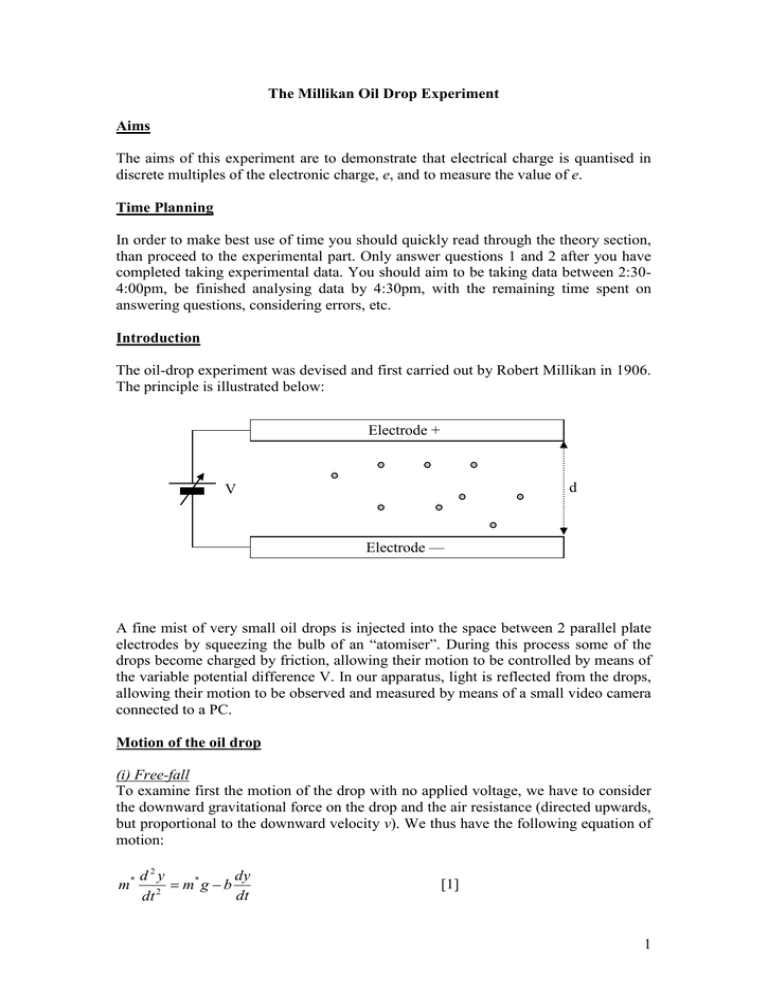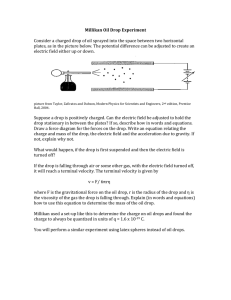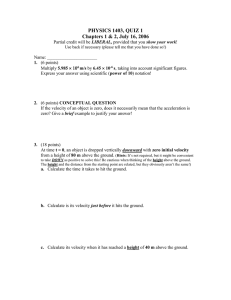The Millikan Oil Drop Experiment
advertisement

The Millikan Oil Drop Experiment Aims The aims of this experiment are to demonstrate that electrical charge is quantised in discrete multiples of the electronic charge, e, and to measure the value of e. Time Planning In order to make best use of time you should quickly read through the theory section, than proceed to the experimental part. Only answer questions 1 and 2 after you have completed taking experimental data. You should aim to be taking data between 2:304:00pm, be finished analysing data by 4:30pm, with the remaining time spent on answering questions, considering errors, etc. Introduction The oil-drop experiment was devised and first carried out by Robert Millikan in 1906. The principle is illustrated below: Electrode + d V Electrode — A fine mist of very small oil drops is injected into the space between 2 parallel plate electrodes by squeezing the bulb of an ―atomiser‖. During this process some of the drops become charged by friction, allowing their motion to be controlled by means of the variable potential difference V. In our apparatus, light is reflected from the drops, allowing their motion to be observed and measured by means of a small video camera connected to a PC. Motion of the oil drop (i) Free-fall To examine first the motion of the drop with no applied voltage, we have to consider the downward gravitational force on the drop and the air resistance (directed upwards, but proportional to the downward velocity v). We thus have the following equation of motion: m* d2y dt 2 m* g b dy dt [1] 1 In [1] the ―effective‖ mass of the drop, m*, incorporates the effect of buoyancy and is 4 3 given by m* r ( oil air ) where r is the radius of the drop and oil and air are 3 the densities of the oil and air respectively. The downward direction is taken to be positive. Solving equation [1] shows that if a drop is released from rest, then the time dependence of its velocity is given by: v(t ) v terminal (1 e bt m * [2] ) i.e, the drop will accelerate until it reaches a constant terminal velocity where the gravitational and air resistance forces are equal, ie m* g bv terminal [3] The time taken for the drop to reach terminal velocity is of the order of m*/b seconds. In this experiment, Stokes’ Law is assumed to be valid, ie b = 6 r, where is the viscosity of air and r the radius of the drop. Thus we have: m* b v terminal 4 3 r ( 3 m* g b air ) oil 2 r2 ( 9 2 r2( 9 1 6 r oil air oil air ) [4] )g [5] QUESTION 1 Estimate the approximate time taken for a free-falling drop to reach terminal velocity using the following data: Density of oil, room temperature: 870 kgm-3 Viscosity of air, standard temperature and pressure: 18 10-6 Pa s Approximate radius of oil drop: r ~1 m We can conclude that for our purposes terminal velocity is reached effectively instantaneously, ie the drop falls with constant velocity given by: v fall m* g b 2 r2 ( 9 oil air )g [6] 2 (ii) In the presence of an electric field If a potential difference V is applied between the plates, then an electric field E = V/d will be set up between the electrodes, and a drop carrying negative charge –q will experience an upward force of magnitude qV/d. The equation of motion then becomes: m* d2y dt 2 qV d m* g b dy , dt [7] and if the voltage is increased so that the drop rises with constant velocity vrise, we have vrise m* g b qV bd [8] So, if we measure vrise in the presence of a constant voltage V, and also vfall for the same drop when V=0, we can obtain a value for the charge q on the drop: v fall vrise qV bd bd (v fall q vrise ) V 6 rd (v fall vrise ) V [9] The only unknown on the RHS of [9] is the drop radius, r. QUESTION 2 Show that r q 9 v fall 2( oil 9 d (v fall V air [10] )g vrise ) 2v fall ( oil 3 air )g [11] We therefore now have a way to find the charge and radius of an oil drop by measuring the downward free-fall velocity and the upward velocity in the presence of an electric field. Experimental Method The demonstrator will show you the basic principles of how to operate the apparatus. The procedure is summarised below: 3 1) Orient the eyepiece scale so that it appears vertical on the computer monitor. Each small division of the scale corresponds to a distance of 1/20 of a mm (ie each large division = 0.5mm). 2) Set the switches U and t on the supply unit to the down position. 3) Squeeze the atomiser bulb and observe the oil drops in the field of view. 4) Switch the plate voltage on with switch U, and adjust the voltage to be in the range of 400-600V, so that a selected drop rises with a speed of about 1-2 small scale divisions per second. 5) Switch the plate voltage off (switch U). 6) As soon as the selected oil drop is located at the height of a selected scale measurement mark, start the time measurement with the switch t. 7) As soon as the drop has fallen by another 20 scale graduation marks (ie 1mm), switch on the plate supply voltage again (switch U). The fall time, te is then automatically recorded in the counter-timer, and measurement of the rise time, tf, begins automatically. 8) As soon as the drop has risen by 20 scale graduation marks, stop the time measurement with switch t. 9) The fall time te and the rise time tf can then be read off from the counter-timer. Record the values of plate voltage, fall and rise times and calculate values for vfall and vrise with appropriate errors. Check your voltage value against the calibrated meter supplied, and correct if necessary. Enter your data into an Excel spreadsheet, entering appropriate formulae to obtain values of q and r for each drop. Repeat for about 20 drops. Calculate values for q and r for each drop as you go along, to ensure that you are obtaining reasonable data. Data Analysis You should find that the charge on each drop is given approximately by: Q Nq0, where N is an integer 1, supporting the hypothesis that charge can only be transferred to the drops in discrete amounts. q0 should be in the region of 2 x 10-19C; this is your first estimate of the magnitude of the electronic charge e. To obtain a more accurate value for e, we must modify Stokes’ law to take account of the fact that the radii of the oil drops is of the same order as the mean free path of air molecules. Thus, the expression for b becomes b 6 rv 1 a r [12] where a is a constant. The effect of this is to introduce a correction factor into the charge measurement, such that the true value of e is expected to be given by: 4 e q0 1 a r 3/ 2 q0 2/3 e2/ 3 1 a r [13] By plotting q02/3 versus 1/r for each drop, you can therefore obtain a value for e together with a value for associated error using the LINEST function in Excel. Required Data oil (T = 22 C) : 873 kgm-3 air (T = 22 C, p = 1.00 x 105 Pa) : 1.18 kgm-3 air (T = 22 C): 18.5 x 10-6 Nsm-2 Electrode plate spacing: d = 6.00 0.02mm 5





